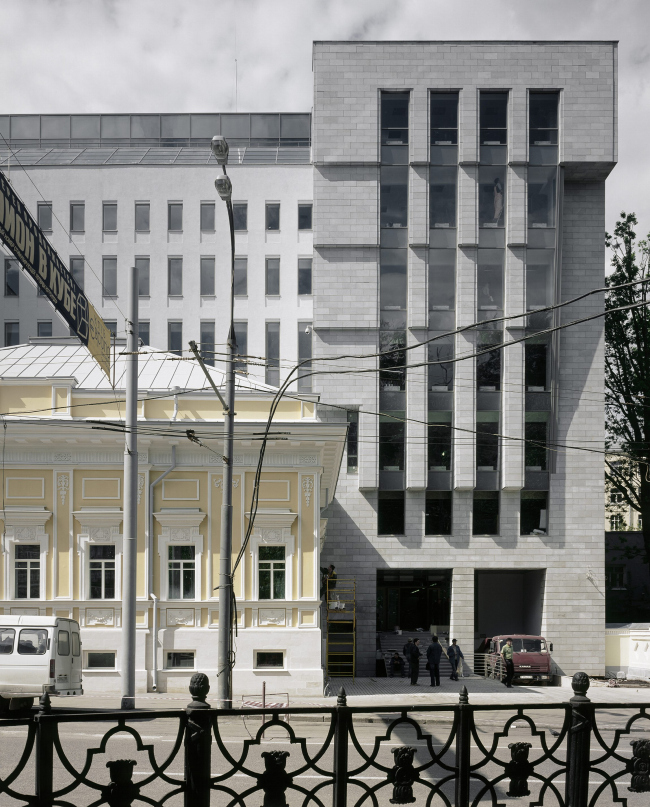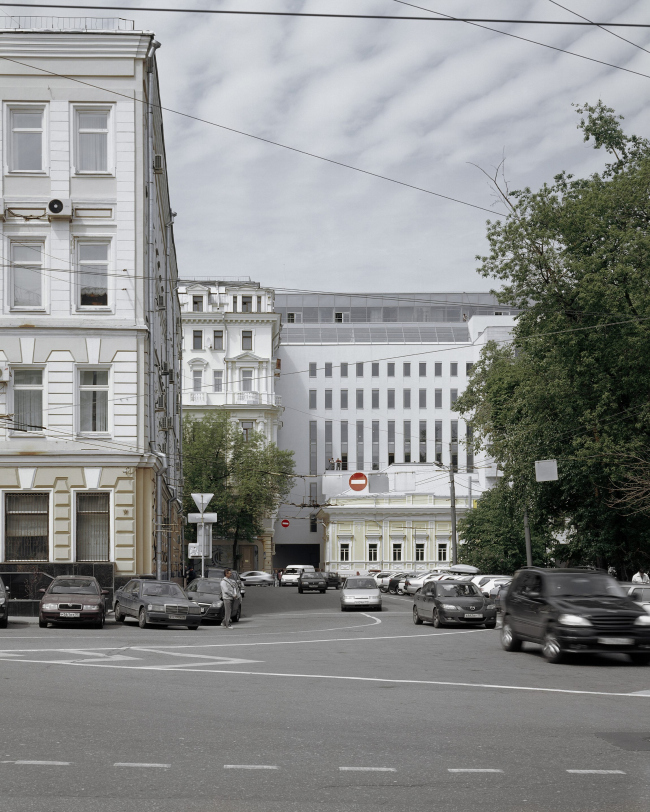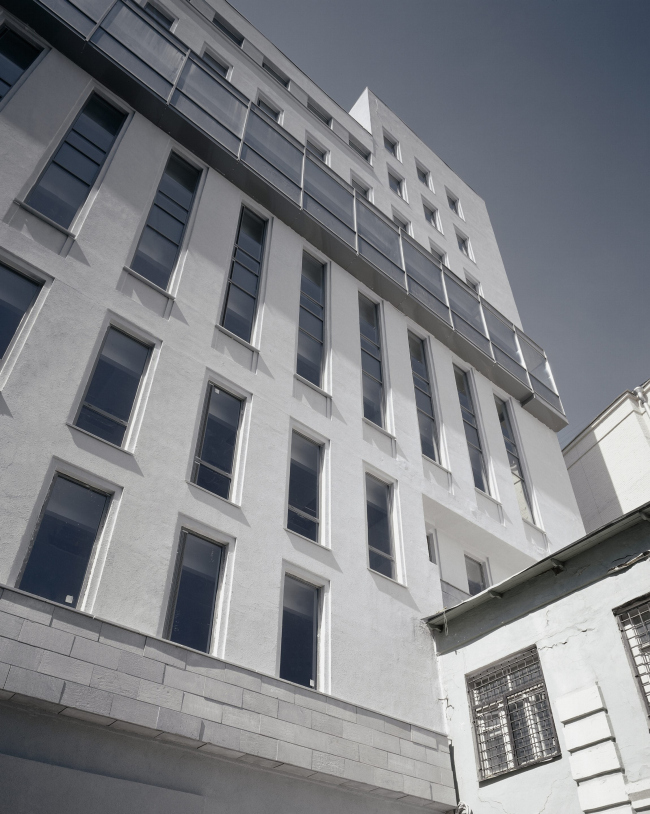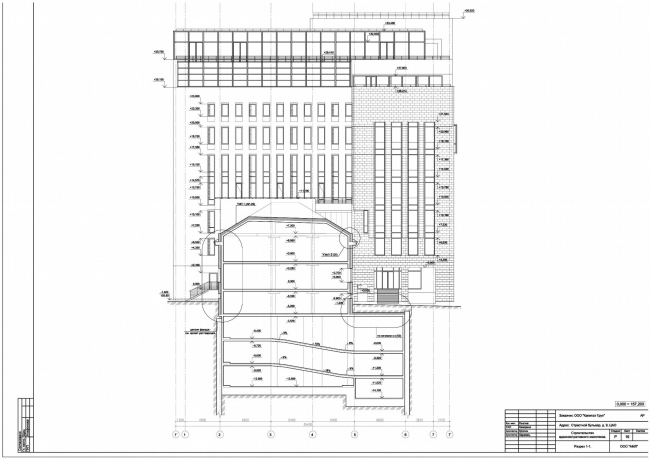|
Published on Archi.ru (https://archi.ru) |
|
| 23.07.2006 | |
|
Really a Moscow house |
|
|
Julia Tarabarina |
|
| Studio: | |
| Architectural workshop Lyzlov («AML») | |
|
The building on Strastnoi Boulevard resembles an ensemble of constructions built at different times, so natural for Moscow that it seems that the author has invented a new sort of contextual architecture, stylizing not some particular "historical" buildings, but the city environment If you walk along Bolshaia Dmitrovka towards the cinema "Russia", in the long view, at the back of the Boulevard, you will see a small house painted yellow with stucco moulding. An unsophisticated passerby will glance at it and will be sure enough the house has always been here, so natural, so Moscow-like it looks. But the antique admirer, remembering well there used to be a construction area a year ago, will surely be annoyed - «again something has been reconstructed in the concrete, moreover, with the proportions being changed». So, who will be right? And what do we have before us – a "typical" Moscow reconstruction of past years or an architectural fantasy on the subject? Here, in the end of Strastnoj Boulevard, used to be a small house, well known, because when it belonged to the playwright A. V. Suhovo-Kobylin, there was murdered Louise Simon-Demansh, his French common-law wife; traces of her blood were discovered in the backyard in coach-house. The literary legend of the house made it quite famous and it became the monument of history and culture. But in 1997, nine years ago, its owner, the joint-stock company Mosrybhoz, had it pulled down. There was to be constructed a hotel but this made the neighbourhood residents infuriated, they were afraid that it would disturb their night rest. But when the Capital Groups company became the owner of the area, it was decided to build an expensive and "quiet" office building; Nikolay Lyzlov was invited for creating the design. Well, the architects have never torn down this monument, but the monument protection commission ordered them to reproduce it. Besides, there are certain restrictions for building in a city center; a new house must be noteworthy enough, but not too eminent… and so on. Then, the customer requires areas. Within rough limits, the architect becomes, so to say, a great master creating art ideas for non-art tasks. This is the same case - all requirements are done with a smile, and the building has wed with the so mixed company of neighbors that it feels like to get to know the way it has been done. First of all, there was no absolute reproduction of Suhovo-Kobylin’s house - it is obvious, that value of a monument is in its history and culture authenticity, and since the original building has been long-lost, any true copy will never replace it. That is why Lyzlov limits the restoration with some improvisation: as the architect has figuratively said - this is one of the best ‘quotations’: the facades are created of the collected of copy items of different Moscow houses dated of the mid of 19th century, and are applied to the concrete volume, extending from the main building completely belonging to it by transitions above and the conjoint garages (there is a low four level one under the entire building). According to Nikolay Lyzlov, the Suhovo-Kobylin’s house does not even challenge to look old, but is created just as a literary allusion to the lost monument. Tuning to the street sizes, it has become a little larger than its prototype - thus there are three levels inside instead of the only one. It is curious that the original house was not finished in the Soviet times as well – by the time of it’s devastation it had already got the third floor from the backyard side. Firstly, it was planned to place a restaurant in the small house and the architect designed a comfortable attic storey, but the entire building was given for the offices, so now it is elegant and simple inside. According to Nikolay Lyzlov, the primary volume of the office building is its neutral "back", its purpose is to serve as a foil to the small house that is up front and also to arrange most of the areas, 20 000 m2 in total. Its height is like those that used to be «profitable house», and the architect refused to stylize one of the "neighbours" (as suggested during a meeting): altogether the surrounding buildings represent a variety of styles - among them and Fedor Osipovich Shehtel’s masterpiece and just ordinary buildings of the 20th century, and a little further, on Pushkin Square, the constructivist building of the "News". In such a diverse company Lyzlov’s building looks elegantly modest. The taut vertical volume, scorning the gravity, hangs over the entrance like a geometrical image of a stoned, and then turned fountain. The angularity of the entrance is emphasized by the concrete plane of the "back", very thin due to the shallow outline of the ledges of window bands flowing in a dashed way, shorter above, longer downwards. The top floor is a fully glazed terrace of the representation part of the office building – it opens a magnificent panoramic view to the entire center of Moscow. Amazingly, the spacious office building, not quoting anything, is really harmonizing the historical area, as though it has always been here. The new house with modest dignity occupies its place in the narrow and motley company, so it is hard to get rid of some mystique notion - it seems, that the house has mysteriously materialized, just because it must be in this place. Must say, such a union of an absolute new construction with surrounding is a rare even for the buildings designed and stylized as historical ones. It seems that Nikolay Lyzlov uses some new way of stylization – not applying a method of imitation, the architect, like in a theatre, "makes play" of the surrounding itself, using schemes so cherished by Muscovites, as if tones of a dear tune. Among Lyzlov’s projects one may discover another building designed with the same approach - it is the house on Myasnickaya, constructed as if entirely composed of buildings’ end faces of the 19th century. The new building does not adapt the “historical style”, but is modeling the lacking history – here used to be a street, a house in it clamped-and-squeezed by neighbours, in a while everything around was pulled down, but it remained, and is showing off today its latent face walls, that used to be unseen. Again, coming round Strastnoi - indeed, what else can be more natural for Moscow, than neighboring of a small house of about 20th century and a glass-concrete verticals behind it? Those who walk will habitually glance at quite familiar shapes of the ‘back’, having not even a clue, that everything has been directed form the start to the end, and observers themselves takes part in the pantomime ‘Moscow and Muscovites’. Nonea part of the facadeNoneNonelayer 1-1 |
|




